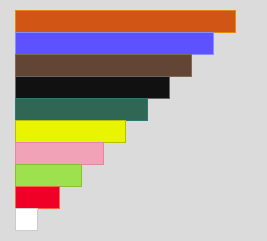Or search by topic
Number and algebra
Geometry and measure
Probability and statistics
Working mathematically
Advanced mathematics
For younger learners
Train Tactics



This is a game for two players. You need one set of ten Cuisenaire rods between you, like this:

Alternatively, you could use the interactivity below.
This game is called Train Tactics. A train is made by putting rods end to end.
The aim of the game is to be the person who places the last rod to complete a train of a particular length.
- One player decides on the length of the final 'train'. (We suggest this is longer than an orange rod but less than the length of five yellow rods.)
- The other player goes first and chooses a rod.
- The second player then chooses another rod and places it end to end with the first rod so there is a single train.
- Players take it in turns in this way, each placing a new rod on the end of the train to make it longer and longer.
- The player who puts down the last rod to make the chosen length wins.
If one player puts down a rod that makes the train longer than the chosen length, then the other player wins.
Try playing the game lots of times.
Do you think it is better to go first or second? Why?
Tell us about any useful strategies (ways of playing or ways of winning) that you have developed.
You may also like
Cuisenaire Squares
These squares have been made from Cuisenaire rods. Can you describe the pattern? What would the next square look like?
Rod Fractions
Pick two rods of different colours. Given an unlimited supply of rods of each of the two colours, how can we work out what fraction the shorter rod is of the longer one?

